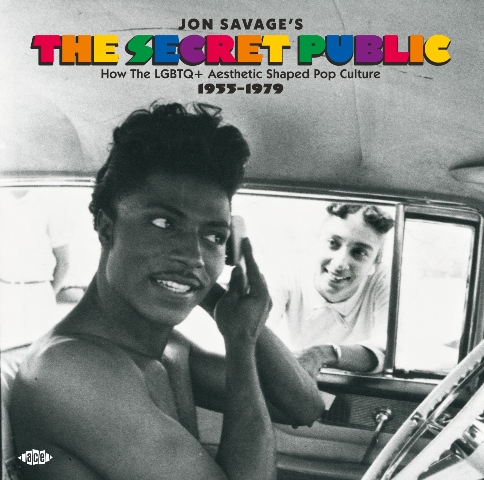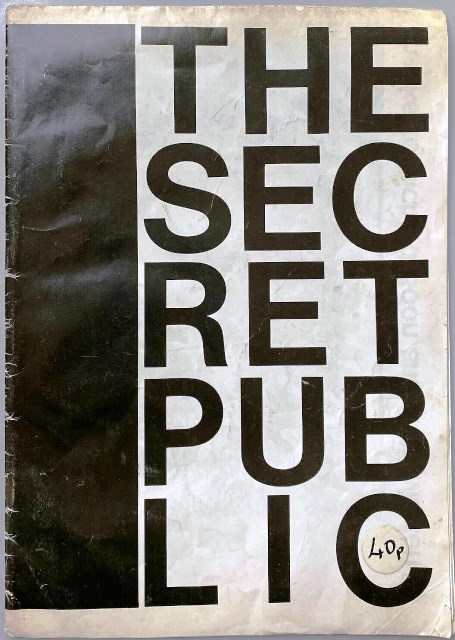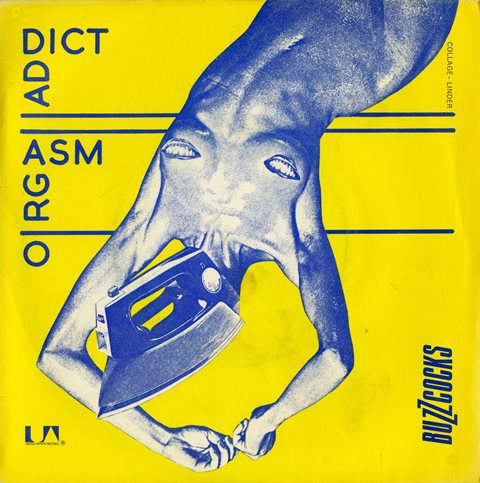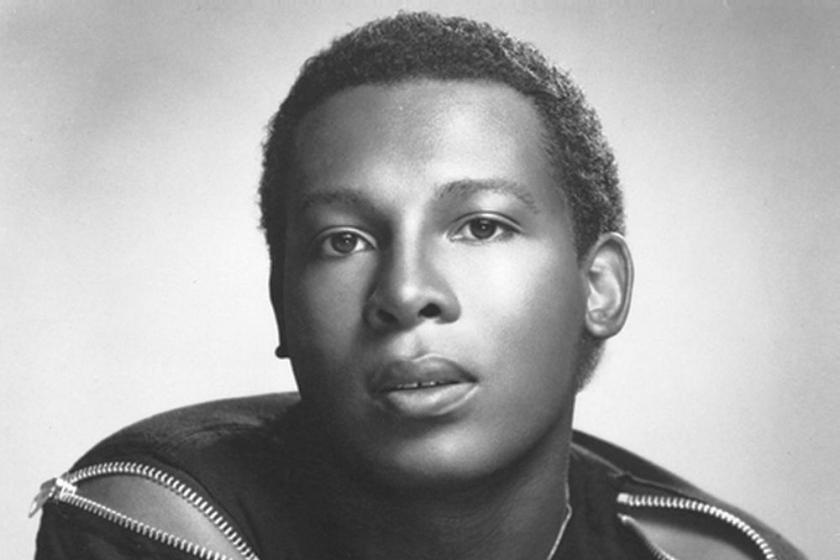Jon Savage's The Secret Public How The LGBTQ+ Aesthetic Shaped Pop Culture 1955-1979 accompanies the titular author/historian/journalist’s book of almost the same name. The Secret Public: How LGBTQ Resistance Shaped Popular Culture (1955–1979) and this 41-track double CD each track exactly what their titles say, drilling into what has often paralleled or underlain yet repeatedly influenced a constantly evolving mainstream.
Little Richard is seen on the cover of the book and the compilation. Other figures crop up twice on the CD set: British producer and songwriter Joe Meek (with Joe Meek & The Blue Men’s "I Hear a New World" and John Leyton's "Johnny Remember me"); Lou Reed (with The Velvet Underground & Nico's "I'll be Your Mirror" and his own “Walk on the Wild Side”); Sylvester Stewart (with his own band Sly & The Family Stone’s “Stand!” and Abaco Dream’s version of his “Life & Death in G & A”); producer/songwriter Bob Crewe (his co-penned songs “Get Dancin' Part 1,” recorded by Disco Tex & The Sex-O-Lettes and “Lady Marmalade,” recorded by LaBelle); producer Patrick Cowley (his version of “I Feel Love” and his mix of Michele’s “Disco Dance”).
 Furthermore, in a way, Little Richard is also present twice on the collection: his “Tutti-Frutti,” the first CD’s second track, is followed by the deeply weird “Esquerita and the Voola” by Esquerita, from whom he heavily borrowed. The double appearances confirm some figures were fundamental to shaping the aesthetic being put under the microscope.
Furthermore, in a way, Little Richard is also present twice on the collection: his “Tutti-Frutti,” the first CD’s second track, is followed by the deeply weird “Esquerita and the Voola” by Esquerita, from whom he heavily borrowed. The double appearances confirm some figures were fundamental to shaping the aesthetic being put under the microscope.
Part of what’s at play is dissemination: telegraphing an ambiance listeners – dancers and DJs too, as well as entrepreneurs – could tune into and then adopt, co-opt or modify for widespread consumption. When “Johnny Remember me” topped the charts in 1961, most record buyers would have had no idea Joe Meek was gay despite the record’s otherness. Some would have tuned in, though. Billy Fury’s “Wondrous Place” is here. He wasn’t gay but his manager Larry Parnes was, meaning Fury’s persona reflected his overseer’s sensibility. It was unspoken, but Parnes wasn't hiding anything. The Velvet Underground were obviously digging into underbellies, but “I'll be Your Mirror” could – just – be taken as a commentary on an, albeit obsessive, relationship along the lines of what later cropped up in Single While Female rather than summing-up a facet of Andy Warhol’s poly-sexual Factory.
The balance between the implicit and the explicit shifted as the late Sixties gave way to the Seventies, a change traced by the chronological track sequencing. Polly Perkins’s “Coochi-Coo” is a May 1973 single from an album titled Liberated Woman. Savage quotes its liner notes: “Liberation for women means society crumbling, marriage ruined, children left to get on with their own scenes, men losing their hold on the purse strings, women fancying other women.” By this point David Bowie (not compiled: “Walk on the Wild Side” is his proxy) had told Melody Maker – in January 1972 – “I’m gay, and always have been.” Savage says this disclosure “was the game-changer.”
 In the booklet, Savage writes “for so long the topic and the realities of homosexual life remained a secret, albeit open ones. The title [Secret Public] also makes the point that gay men and lesbians were the public, were part of societies that, for a long time, desired to erase their existence. It also recognises that, in the early Seventies, what had once been secret became public knowledge, and that that was ultimately liberating for all.”
In the booklet, Savage writes “for so long the topic and the realities of homosexual life remained a secret, albeit open ones. The title [Secret Public] also makes the point that gay men and lesbians were the public, were part of societies that, for a long time, desired to erase their existence. It also recognises that, in the early Seventies, what had once been secret became public knowledge, and that that was ultimately liberating for all.”
Yet he also discloses “while working at [music weekly] Sounds [from 1977], I was very friendly with another writer, Jane Suck. We were both gay, but we never talked about it, ever. When I went to San Francisco in early autumn 1978, I interviewed the Screamers - the pioneering synth punk group. Two out of the three members were gay: we talked about technology and the souring of Punk rock, but about our mutual homosexuality, not a word. The music industry, apart from the brave stance of Tom Robinson [whose “Glad to be Gay” is heard], was still very closeted and averse to the topic.” Set this against gay, lesbian and trans venues as safe spaces during the early punk era: Club Louise, for Sex Pistols and their crowd; Foo Foo’s and The Ranch in Manchester; London’s prime punk dump The Roxy had been gay nightspot Chagurama – one of its habitués, Chelsea’s Gene October, was central to bringing punk through its doors.
 For Savage, the new book and the CD set are components of a personal continuum. The Secret Public was the name of an art fanzine Savage published in January 1978 with photomontage artist Linder Sterling (pictured above left): her work had already featured on the cover of Buzzcocks’s November 1977 single “Orgasm Addict” (pictured right), included on the CD. In 2006, Savage compiled the Queer Noises 1961-1978: From The Closet To The Charts CD: common to it and the Secret Public set are The Kinks, Joe Meek, The Miracles (with the same track “Ain't Nobody Straight in L.A.”), Polly Perkins (also with the same track, “Coochi-Coo”) and Secret Public’s climactic, final contributor Sylvester.
For Savage, the new book and the CD set are components of a personal continuum. The Secret Public was the name of an art fanzine Savage published in January 1978 with photomontage artist Linder Sterling (pictured above left): her work had already featured on the cover of Buzzcocks’s November 1977 single “Orgasm Addict” (pictured right), included on the CD. In 2006, Savage compiled the Queer Noises 1961-1978: From The Closet To The Charts CD: common to it and the Secret Public set are The Kinks, Joe Meek, The Miracles (with the same track “Ain't Nobody Straight in L.A.”), Polly Perkins (also with the same track, “Coochi-Coo”) and Secret Public’s climactic, final contributor Sylvester.
Similarly, to varying degrees, Savage’s major historical books seek to contextualise and bring understanding to aspects of what he has lived through, his own experiences. England's Dreaming: Sex Pistols and Punk Rock (1991) brought shape and perspective, both of which were out of reach during 1976 and 1977 as he chronicled what was going on in real time. Teenage: The Creation of Youth Culture (2007) scrutinised the previously unfamiliar prehistory of the youth phenomenon which framed him. 1966: The Year the Decade Exploded (2015) centred on the year he became a teenager. Now, The Secret Public book and CD set.
While integral to a wider picture, the splendidly annotated and packaged Jon Savage's The Secret Public How The LGBTQ+ Aesthetic Shaped Pop Culture 1955-1979 does, nonetheless, stand on its own. A thrilling, thought-provoking consideration of nonconformism in the pre-AIDS era, this is a significant release.
- Next week: The Beatles - Stowe School 1963
- More reissue reviews on theartsdesk
- Kieron Tyler’s website















Add comment